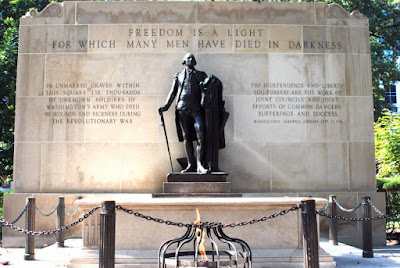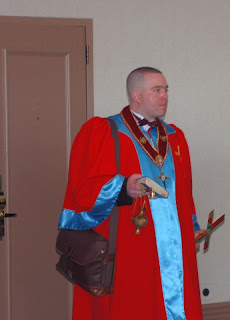 |
| W. Bro. David Lindez and three Masons from Haiti display the flag of Haiti. |
Only at Alpha Lodge can the Master bring the brethren to Haiti without having to move the charter!
The journey through time and space took place Wednesday night, as the lodge catered to the five senses in recreating the Haitian Masonic experience, topped with the screening of a video documenting the St. John’s Day festivities held last June in Jacmel, Haiti.
We departed New Jersey upon entering the lodge room. The air was thick with incense of various aromas. The only illumination was the G and the collective glow of scores of candles: beeswax tapers about the altar; others in the South, West and East, and elsewhere about the lodge.
 |
| Do not adjust your monitor. This image captures the candle-lit, incense-laden atmosphere inside historic Alpha Lodge during its sojourn to Haiti. |
W. Bro. David Lindez gave the brethren a history of Freemasonry in Haiti, a very colorful description that goes a long way toward explaining the highly esoteric nature of the fraternity there. It’s the story of Pasqually, Willermoz, Rectified Scottish Rite, Strict Observance, and Elu Cohens.
 Then the brethren adjourned downstairs for the feast, a true Masonic Agape with exotic dishes (goat!) and other ethnic comestibles on the menu, all homemade right in the lodge’s kitchen by an experienced chef.
Then the brethren adjourned downstairs for the feast, a true Masonic Agape with exotic dishes (goat!) and other ethnic comestibles on the menu, all homemade right in the lodge’s kitchen by an experienced chef.The Grand Orient d’Haiti dates to 1824. Its 6,000 brethren are at labor in 51 lodges found among numerous cities and towns. The lodge shown in the video is Parfaite Sincerite No. 4 in Jacmel.
This documentary shows the lodge’s annual public procession in celebration of St. John the Baptist Day 2008. Now it’s one thing to listen to Bro. Trevor Stewart discuss the Masonic processions of 18th century Britain, but it is quite something else to view the esoterica, solemnity, hierarchy and regalia of the Haitian brethren as they undertake their culturally significant ritual, enduring what looked like crippling heat, in a public square.
 It is not easy to describe all that was captured by the camera, but it must be explained that the Freemasonry of this island nation is commingled with church, resulting in Masonic and ecclesiastic organizations running parallel, if not actually integrated. The hierarchy of those in the procession was evident. Those attired in regalia marked with Templar crosses comprise the inner ring of a huge throng of circumambulating Masons encircling the altar. A pyre actually, built of specially chosen woods with sacramental elements liberally splashed upon it and prayers inscribed on paper ritually placed within it. The next ring of celebrants is attired in what Scottish Rite Masons would recognize as Rose Croix regalia. Look closely! There’s Bro. David from All Seeing Eye Lodge in New York! Still others display the Triple Tau. The Master Masons, easily identified by their aprons, form the outermost ring of Masons; those outside of that are family and friends of the brethren. All carry candles to illumine the massive procession, except those bearing the banners of their respective Orders, plus one brother with a Flaming Sword. All are barefoot, for they know the ground where they walk is sacred.
It is not easy to describe all that was captured by the camera, but it must be explained that the Freemasonry of this island nation is commingled with church, resulting in Masonic and ecclesiastic organizations running parallel, if not actually integrated. The hierarchy of those in the procession was evident. Those attired in regalia marked with Templar crosses comprise the inner ring of a huge throng of circumambulating Masons encircling the altar. A pyre actually, built of specially chosen woods with sacramental elements liberally splashed upon it and prayers inscribed on paper ritually placed within it. The next ring of celebrants is attired in what Scottish Rite Masons would recognize as Rose Croix regalia. Look closely! There’s Bro. David from All Seeing Eye Lodge in New York! Still others display the Triple Tau. The Master Masons, easily identified by their aprons, form the outermost ring of Masons; those outside of that are family and friends of the brethren. All carry candles to illumine the massive procession, except those bearing the banners of their respective Orders, plus one brother with a Flaming Sword. All are barefoot, for they know the ground where they walk is sacred.The small group of men at the very center, those applying the sea salt, holy water and other elements to the ritual pyre, are not adorned with special symbols. Simple white. Everyone knows who they are.
 And this procession is not mere marching. On the stone pavement about the altar is drawn a circular map of spiritual progression revealing the first 24 names of the Shemhamphorasch. (One must be very careful here. This is not for the casual, kidding himself Kabbalist. These divine signs often are exploited by hard-hearted manipulators of hedonists and other weaklings.) The brethren here affect ritual steps, just as one would upon entering or leaving the lodge, signifying their conformity with one another and with deity.
And this procession is not mere marching. On the stone pavement about the altar is drawn a circular map of spiritual progression revealing the first 24 names of the Shemhamphorasch. (One must be very careful here. This is not for the casual, kidding himself Kabbalist. These divine signs often are exploited by hard-hearted manipulators of hedonists and other weaklings.) The brethren here affect ritual steps, just as one would upon entering or leaving the lodge, signifying their conformity with one another and with deity.It is a dizzying demonstration. The heat of the pyre warms your face, and the humidity in the air hugs the body. The juxtaposition of familiar symbols with foreign rites renders the whole scene dreamlike and cinematic, and yet nothing to these Masons is more real and immediate than this ritual. The power of the union achieved by the brethren is palpable.
The film ends. The lights come up. We are returned from Haiti.





































































































